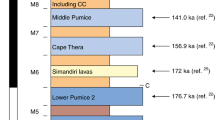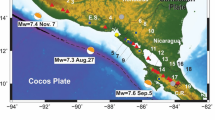Abstract
Volcanic activity has frequently been linked to Quaternary environmental change, either by driving climate modification1,2 or in response to environmental changes3. Although a link has been established between large explosive eruptions and small (0.5 °C), brief (1–2 years) falls in global temperatures4, both the evidence and mechanisms responsible for longer episodes of eruption-induced planetary cooling remain questionable1,2,5,6. In contrast, recent research based on ice-core data suggests that rapid climate changes during the past 110,000 years increased explosive volcanic activity7. Here we present a statistical analysis relating the frequency of explosive activity of Mediterranean volcanoes — based on dated8,9,10,11 tephra layers in deep-sea sediment cores — to the rate of late Quaternary sea-level change. The nonlinear correlation between the two is tentatively explained in terms of dynamic responses of the volcanoes to stress-related influences on various spatial scales. The correlation supports a mechanism or mechanisms by which the climate-driven growth and decay of large ice sheets can influence the eruptive chronologies of distant volcanic edifices via changes in global sea level.
This is a preview of subscription content, access via your institution
Access options
Subscribe to this journal
Receive 51 print issues and online access
$199.00 per year
only $3.90 per issue
Buy this article
- Purchase on Springer Link
- Instant access to full article PDF
Prices may be subject to local taxes which are calculated during checkout




Similar content being viewed by others
References
Bray, J. R. Pleistocene volcanism and glacial initiation. Science 197, 251–254 (1977).
Rampino, M. & Self, S. Volcanic Winter and accelerated glaciation following the Toba super-eruption. Nature 359, 50–52 (1992).
Hall, K. Rapid deglaciation as an initiator of volcanic activity: an hypothesis. Earth Surf. Process. Landforms 7, 45–51 (1982).
Dutton, E. G. & Christy, J. R. Solar radiative forcing at selected locations and evidence for global lower tropospheric cooling following the eruptions of El Chichó and Pinatubo. Geophys. Res. Lett. 19, 2313–2316 ((1992)).
Ninkovitch, D. & Donn, W. L. Explosive Cenozoic volcanism and climatic implications. Science 194, 899–906 (1976).
Rampino, M. R., Self, S. & Fairbridge, R. W. Can rapid climate change cause volcanic eruptions? Science 206, 826–828 (1979).
Zielinski, G. A., Mayewski, P. A., Meeker, L. D., Whitlow, S. & Twickler, M. S. An 110,000-year record of explosive volcanism from the GISP2 (Greenland) ice core. Quat. Res. 43, 109–118 (1996).
Keller, J., Ryan, W. B. F., Ninkovitch, D. & Altherr, R. Explosive volcanic activity in the Mediterranean over the past 200,000 yr as recorded in deep-sea sediments. Geol. Soc. Am. Bull. 89, 591–604 (1978).
Vinci, A. Distribution and chemical composition of tephra layers from eastern Mediterranean abyssal sediments. Mar. Geol. 64, 143–155 (1985).
Paterne, M., Guichard, F., Labeyrie, J., Gillot, P. Y. & Duplessy, J. C. Tyrrhenian sea tephrochronology of the oxygen isotope record for the past 60,000 years. Mar. Geol. 72, 259–285 (1986).
Paterne, M., Guichard, F. & Labeyrie, J. Explosive activity of the south Italian volcanoes during the past 80,000 years as determined by marine tephrochronology. J. Volcanol. Geotherm. Res. 34, 153–172 (1988).
Sigvaldason, G. E., Annertz, K. & Nilsson, M. Effect of glacier loading/deloading on volcanism: postglacial volcanic eruption rate of the Dyngjufjöll area, central Iceland. Bull. Volcanol. 54, 385–392 (1992).
Nakada, M. & Yokose, H. Ice-age as a trigger of active Quaternary volcanism and tectonism. Tectonophysics 212, 321–329 (1992).
Matthews, R. K. Tectonic implications of glacio-eustatic sea-level fluctuations. Earth Planet. Sci. Lett. 5, 459–462 (1969).
Wallmann, P. C., Mahood, G. A. & Pollard, D. D. Mechanical models for correlation of ring-fracture eruptions at Pantelleria, Strait of Sicily, with glacial sea-level drawdown. Bull. Volcanol. 50, 327–339 (1988).
Zielinski, G. A. et al. Volcanic aerosol records and tephrochronology of the Summit, Greenland, ice cores. J. Geophys. Res. (in the press).
Paterne, M., Labeyrie, J., Guichard, F., Mazaud, A. & Maitre, F. Fluctuations of the Campanian explosive volcanic activity (south Italy) during the past 190,000 years, as determined by marine tephrochronology. Earth. Planet Sci. Lett. 98, 166–174 (1990).
Paterne, M. & Guichard, F. Triggering of volcanic pulses in the Campanian area, south Italy, by periodic deep magma influx. J. Geophys. Res. 98, 1861–1873 (1993).
Blanchon, P. & Shaw, J. Reef drowning during the last glaciation: evidence for catastrophic sea-level rise and ice-sheet collapse. Geology 23, 4–8 (1995).
Cox, D. R. & Lewis, P. A. W. The Statistical Analysis of Series of Events 2nd edn (Methuen, London, (1978)).
Solow, A. R. Testing for change in the frequency of El Niño events. J. Clim. 8, 2563–2566 (1995).
Bebbington, M. S. & Lal, C. D. On homogeneous models for volcanic eruptions. Math. Geol. 28, 585–600 (1996).
Fairbanks, R.. C. A17,000-year glacio-eustatic sea-level record: influence of glacial melting rates on the Younger Dryas event and deep-ocean circulation. Nature 342, 637–642 (1989).
Shackleton, N. J. Oxygen isotopes, ice volume and sea level. Quat. Sci. Rev. 6, 183–190 (1987).
Cleveland, W. S., Grosse, E. & Shyu, W. M. in Statistical Models in S (eds Chambers, J. M. & Hastie, T.) 309–376 (Wadsworth & Brooks/Cole, Pacific Grove, CA, (1992)).
Acknowledgements
This work was supported by the Commission of the European Communities, DG XII, Environment Programme, Climatology and Natural Hazards Unit.
Author information
Authors and Affiliations
Corresponding author
Rights and permissions
About this article
Cite this article
McGuire, W., Howarth, R., Firth, C. et al. Correlation between rate of sea-level change and frequency of explosive volcanism in the Mediterranean. Nature 389, 473–476 (1997). https://doi.org/10.1038/38998
Received:
Accepted:
Issue Date:
DOI: https://doi.org/10.1038/38998
This article is cited by
-
Sensitivity of Santorini eruption model predictions to input conditions
Nature Geoscience (2023)
-
Dyke to sill deflection in the shallow heterogeneous crust during glacier retreat: part I
Bulletin of Volcanology (2023)
-
Low-volume magmatism linked to flank deformation on Isla Santa Cruz, Galápagos Archipelago, using cosmogenic 3He exposure and 40Ar/39Ar dating of fault scarps and lavas
Bulletin of Volcanology (2022)
-
The build-up and triggers of volcanic eruptions
Nature Reviews Earth & Environment (2021)
-
Eruptive activity of the Santorini Volcano controlled by sea-level rise and fall
Nature Geoscience (2021)
Comments
By submitting a comment you agree to abide by our Terms and Community Guidelines. If you find something abusive or that does not comply with our terms or guidelines please flag it as inappropriate.



